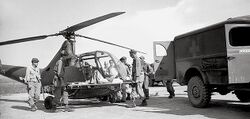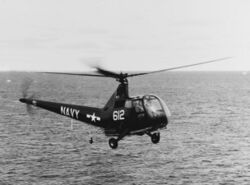Engineering:Sikorsky R-6
| R-6 / Hoverfly II | |
|---|---|

| |
| R-6A Hoverfly II in flight | |
| Role | Helicopter |
| National origin | United States |
| Manufacturer | Sikorsky Aircraft |
| First flight | 15 October 1943 |
| Introduction | 1945 |
| Status | Retired |
| Primary users | United States Navy Royal Air Force |
| Number built | 225 |
| Developed from | Sikorsky R-4 |
The Sikorsky R-6 is an American light two-seat helicopter of the 1940s. In Royal Air Force and Royal Navy service, it was named the Hoverfly II.
Development
The R-6/Hoverfly II was developed to improve on the successful Sikorsky R-4. In order to enhance performance, a completely new streamlined fuselage was designed and the boom carrying the tail rotor was lengthened and straightened. The main rotor and transmission system of the R-4 were retained.[1] Sikorsky allotted their Model 49 designation to the new design. Later, dynamically balanced modifications to the rotor were carried out by Doman Helicopters Inc. The new aircraft could attain 100 mph (160 km/h) compared with 82 mph (132 km/h) by the earlier design.
Initial production was by Sikorsky, but most examples were built by Nash-Kelvinator. Some of the later aircraft were fitted with more powerful engines.
Operational history
The first R-6s were delivered to the United States Army Air Forces (USAAF) in late 1944 and some were transferred to the United States Navy (USN). It was initially intended to pass 150 R-6s to the Royal Air Force (RAF), but delays caused by the switch of production from Sikorsky's factory at Stratford, Connecticut, to Nash-Kelvinator at Detroit, Michigan, meant that only 27 R-6As were actually delivered to the RAF as the Hoverfly II.[2] Fifteen of these were passed on to the Royal Navy's Fleet Air Arm (FAA).[3]
Some of the RAF examples were allotted to 657 Squadron RAF for proving the use of helicopters in the Army Co-operation role, and two external stretchers could be fitted to the fuselage. 657 Squadron operated their Hoverfly IIs as Air Observation Posts, spotting for Army artillery units. The Hoverfly IIs remained in operation until April 1951, and one squadron example was displayed at the September 1950 Farnborough Air Show.[4]
The FAA used their Hoverfly IIs in the training and liaison roles. Naval units to use the type included 771 Squadron from December 1945, followed by 705 Squadron.
The USAAF operated their R-6s in secondary roles and the survivors were redesignated H-6A in 1948. The USN examples were designated the HOS-1 and a further 64 were intended to be transferred from the USAAF, but this did not take place.
Disposals of surplus military S-49s were made in the civil market in the late 1940s but none now remain in operation. Four are currently displayed in US museums.[5]
Variants
- XR-6
- prototype powered by a 225 hp (168 kW) Lycoming O-435-7 (one)
- XR-6A
- as XR-6 but powered by the 240 hp (180 kW) Franklin O-405-9 (five) of which three to the US Navy as XHOS-1
- YR-6A
- as XR-6A with small changes (26) built by Nash-Kelvinator
- R-6A
- production model (193) built by Nash-Kelvinator of which 36 to US Navy as HOS-1 and 27 to the RAF as Hoverfly II
- R-6B
- projected variant with 225 hp (168 kW) Lycoming O-435-7, but not proceeded with
- XR-7
- projected development of the XR-6 with a 240 hp (180 kW) Franklin O-405-9 engine, not built.
- Doman LZ-1
- One R-6A modified as a testbed
- Doman LZ-1A
- One R-6A modified as a testbed with a Doman-designed hingeless rotor blades and self-lubricating rotor hub.
Operators
 United Kingdom
United Kingdom
 United States
United States
- United States Army Air Forces [6]
- 162nd Liaison Squadron
- United States Air Force
- 72d Liaison Squadron[7]
- United States Coast Guard[6]
- United States Navy[6]
 Mexico
Mexico
Aircraft on display
- 43-45462 – R-6A on static display at the Museo Militar de Aviacion in Santa Lucía Air Force Base Num 1 .[8]
- 43-45473 – R-6A on static display at the United States Army Aviation Museum at Fort Rucker near Ozark, Alabama.[9]
- 43-45379 – R-6A on static display at the National Museum of the United States Air Force in Dayton, Ohio.[10]
- 43-45480 – LZ-1A on static display at the New England Air Museum in Windsor Locks, Connecticut. It was converted by Doman from the R-6.[11]
- 43-45531[12] – R-6 under restoration at the American Helicopter Museum and Education Center in West Chester, Pennsylvania.[13]
Specifications (R-6A)
Data from Thetford, 1977
General characteristics
- Crew: one
- Capacity: one observer
- Length: 47 ft 11 in (14.61 m)
- Gross weight: 2,600 lb (1,179 kg)
- Powerplant: 1 × Franklin O-405-9 piston, 240 hp (180 kW)
- Main rotor diameter: 38 ft 0 in (11.58 m)
Performance
- Maximum speed: 100 mph (160 km/h, 87 kn)
- Service ceiling: 10,000 ft (3,000 m)
See also
Related development
References
Notes
- ↑ Swanborough, 1963, p.529
- ↑ Butler, 2004, p.278
- ↑ Thetford, 1977, p.422
- ↑ Thetford, 1976, p.603
- ↑ Ogden, 2007, p.602
- ↑ Jump up to: 6.0 6.1 6.2 6.3 "S-49/R-6A/HOS-1/Hoverfly". sikorskyarchives.com. 2018. https://www.sikorskyarchives.com/S-49.php.
- ↑ "Factsheet 72 Helicopter Squadron (ACC)". Air Force Historical Research Agency. April 9, 2008. https://www.afhra.af.mil/About-Us/Fact-Sheets/Display/Article/433579/72-helicopter-squadron/.
- ↑ "Sikorsky R-6A Hoverfly II". 26 April 2017. http://stanakshot.free.fr/affichage3.php?appareil=Sikorsky+R-6A+Hoverfly+II/.
- ↑ "Airframe Dossier - Sikorsky-Nash-Kelvinator R-6A, s/n 43-45473 US, c/r N5282N". AerialVisuals.ca. 29 October 2016. http://www.armyaviationmuseum.org/aircraft-collection/rotary-wing.
- ↑ "Sikorsky R-6A Hoverfly II". 20 April 2015. http://www.nationalmuseum.af.mil/Visit/Museum-Exhibits/Fact-Sheets/Display/Article/196253/sikorsky-r-6a-hoverfly-ii/.
- ↑ "Sikorsky R-6 Doman Conversion (LZ-1A)". http://neam.org/ac-sikorsky-r6.php.
- ↑ Ogden, 2007
- ↑ "Aircraft Being Restored". http://americanhelicopter.museum/aircraft-being-restored.
Bibliography
- Butler, Phil (2004). Air Arsenal North America. Midland Publishing. ISBN 1-85780-163-6.
- Ogden, Bob (2007). Aviation Museums and Collections of North America. Air-Britain (Historians) Ltd. ISBN 978-0-85130-385-7.
- Swanborough, F.G. (1963). United States Military Aircraft since 1909. Putnam & Company Ltd.
- Thetford, Owen (1976). Aircraft of the Royal Air Force since 1918. Putnam & Company Ltd. ISBN 0-370-10056-5.
- Thetford, Owen (1977). British Naval Aircraft since 1912. Putnam & Company Ltd. ISBN 0-370-30021-1.
External links
- Sikorsky S-49/R-6A/HOS-1/Hoverfly Mk II page at the Sikorsky Archives
- Sikorsky R-6A page at the National Museum of the United States Air Force
- Data and image of R-6
 |




